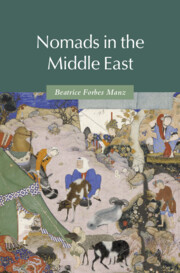Book contents
- Nomads in the Middle East
- Series page
- Nomads in the Middle East
- Copyright page
- Dedication
- Additional material
- Contents
- Figures and Maps
- Preface
- Maps
- Debate between Sheep and Grain
- 1 Introduction
- 2 Nomads in the Establishment of the Caliphate
- 3 The Rise of New Peoples and Dynasties
- 4 Turkic Tradition and Seljuqid Rule
- 5 Mongol Conquest and Rule
- 6 After the Mongols: Timurids, Turkmen and Ottomans
- 7 The Rise of Nomad Tribes,1500–1800
- 8 Nomads in the Modern Middle East
- 9 Conclusion
- Bibliography
- Index
7 - The Rise of Nomad Tribes,1500–1800
Published online by Cambridge University Press: 12 November 2021
- Nomads in the Middle East
- Series page
- Nomads in the Middle East
- Copyright page
- Dedication
- Additional material
- Contents
- Figures and Maps
- Preface
- Maps
- Debate between Sheep and Grain
- 1 Introduction
- 2 Nomads in the Establishment of the Caliphate
- 3 The Rise of New Peoples and Dynasties
- 4 Turkic Tradition and Seljuqid Rule
- 5 Mongol Conquest and Rule
- 6 After the Mongols: Timurids, Turkmen and Ottomans
- 7 The Rise of Nomad Tribes,1500–1800
- 8 Nomads in the Modern Middle East
- 9 Conclusion
- Bibliography
- Index
Summary
The Ottomans and Safavids had different policies towards nomads, but in both states nomads played an important role. The Safavids retained a strong nomad presence in the army, with tribal structure in both army and administration, organizing their followers in oymaqs. When these threatened the power of the state, Iranians and slave soldiers were brought in as counterweight, but the oymaqs remained in place. The Ottomans attempted fuller control but had to grant considerable autonomy in regions far from the center: eastern Anatolia, the Syrian desert, and the Arabian Peninsula. Competition between the two states led to shifting borders, in which nomad tribal powers allied with one or another state. Thus a largely nomad buffer region developed, stretching from Kurdistan to the Persian Gulf. Especially in Iran, the eighteenth century was a period of decentralization, when nomad tribes gained in power. This chapter discusses the lifestyle of nomads, for which sources are fuller at this period, and the role of firearms relative to nomad power.
- Type
- Chapter
- Information
- Nomads in the Middle East , pp. 168 - 198Publisher: Cambridge University PressPrint publication year: 2021



